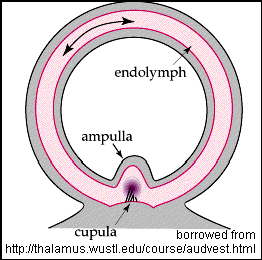Date: Fri Sep 26 21:14:58 2003
Posted By: Alex Goddard,
Area of science: Neuroscience
ID: 1060332189.Ns
Message:
Hi-
That's a good question! The basic answer is that it
would indeed help a little bit - it would help things get back to normal
faster than if you stood still. But you still might be a little dizzy at
first when you're trying to spin the other way.
To understand what's really going on, we need to know
some nitty
gritty details. The vestibular system is what your body uses to
figure out if
you are lying down, standing up, leaning to the side, spinning, etc. It is
comprised
of the semicircular canals, the utricle, and the saccule. When you're
spinning, you're
feeling your semicircular canals at work.
I'll try to give a bit of detail here. (More in
depth info can be found at http://thalamus.wustl.
edu/course/
audvest.html, under part E: the semicircular canals.)
 Inside your ear, the semicircular canals are filled
with fluid; they detect rotation of your head in space (like when you
shake
your head side to side, or when you're in a car that's turning). There
are
three canals in each ear, detecting 3 dimensions of motion. Roughly
speaking, these dimensions of movement are shaking your head (as if to
say
'no'), touching your ear to your shoulder, and touching your chin to your
chest.
Inside your ear, the semicircular canals are filled
with fluid; they detect rotation of your head in space (like when you
shake
your head side to side, or when you're in a car that's turning). There
are
three canals in each ear, detecting 3 dimensions of motion. Roughly
speaking, these dimensions of movement are shaking your head (as if to
say
'no'), touching your ear to your shoulder, and touching your chin to your
chest.
Inside these canals, fluid flows around the canals
and
can slosh against the cupula. The cupula is a gelatinous goop
which
is attached to hair cells, the cells which send the 'balance' signal to
your
brain. When you move your head, the fluid can't react as fast as
your
head does. The fluid pushes against the cupula,
which causes the hair cells to move.
It's somewhat like you putting an oar into the
water of a river you were canoeing down - the moving water (fluid) would
push
your oar (the cupula) back. The hair cells would be like your arm - you'd
detect that oar was being pushed back!
So, as we said, when you start spinning, the cupula
gets pushed on by the fluid. But if you were to keep on spinning at the
same
speed for a little bit, the fluid would catch up with your head, and would
be spinning
at the same rate as the rest of
you - and you would stop feeling dizzy. But once you stopped, the fluid
would want to keep flowing at the speed you were spinning, and
slosh up
against your cupula again - making you dizzy again!
If you start spinning the other way, you would be
exerting
another force trying to push the fluid into the new direction of motion.
This means you would be pushing on your cupula even more than if you just
stopped. But that would be short lived, as the fluid would eventually
succumb to the force from the other direction, bring it to stop more
quickly. (and if you keep on spinning you'll get it going in the
new
direction).
I hope that makes sense. In summary, the fluid in
your
ears still sloshing around causes you to feel dizzy when you stop spinning
in one
direction.
If you turn the other way, you will drive that fluid to start spinning
the
other way. This will cause the fluid to come to a stop sooner than if you
just tried to stand still (but not immediately)!
-Alex G
cgoddard@fas.harvard.edu
Current Queue |
Current Queue for Neuroscience |
Neuroscience archives
Try the links in the MadSci Library for more information on Neuroscience.
MadSci Home | Information |
Search |
Random Knowledge Generator |
MadSci Archives |
Mad Library | MAD Labs |
MAD FAQs |
Ask a ? |
Join Us! |
Help Support MadSci
MadSci Network,
webadmin@www.madsci.org
© 1995-2003. All rights reserved.
 Inside your ear, the semicircular canals are filled
with fluid; they detect rotation of your head in space (like when you
shake
your head side to side, or when you're in a car that's turning). There
are
three canals in each ear, detecting 3 dimensions of motion. Roughly
speaking, these dimensions of movement are shaking your head (as if to
say
'no'), touching your ear to your shoulder, and touching your chin to your
chest.
Inside your ear, the semicircular canals are filled
with fluid; they detect rotation of your head in space (like when you
shake
your head side to side, or when you're in a car that's turning). There
are
three canals in each ear, detecting 3 dimensions of motion. Roughly
speaking, these dimensions of movement are shaking your head (as if to
say
'no'), touching your ear to your shoulder, and touching your chin to your
chest.